As a part of our studio build-out in Walton, we had to install a high-capacity STL system between the studio and transmitter site. Basically, there are five radio stations associated with this studio and the satellite dish and receivers are going to be located at the transmitter site.
The audio over IP gear is getting really sophisticated and better yet, more reliable. For this application, we are using a Cambium networks (Motorola Canopy) PTP-250 radio set and a pair of Wheatstone IP88 blades on either site. Since there is quite a bit of networked gear at the transmitter site, the IP88s will live on their own VLAN. The PTP-250s will pass spanning tree protocol, rapid spanning tree protocol, 802.1Q, and other layer two traffic.
The Wheatsone IP88A blades are the heart of the system. Not only do they pass 16 channels of audio, we can also pass 8 logic closures bi-directionally. This is key because we are shipping satellite audio and contact closures back from the transmitter site. The IP88A setup is fairly easy, once the IP address is entered. The web GUI is used for the rest of the configurations including making the connections between units.
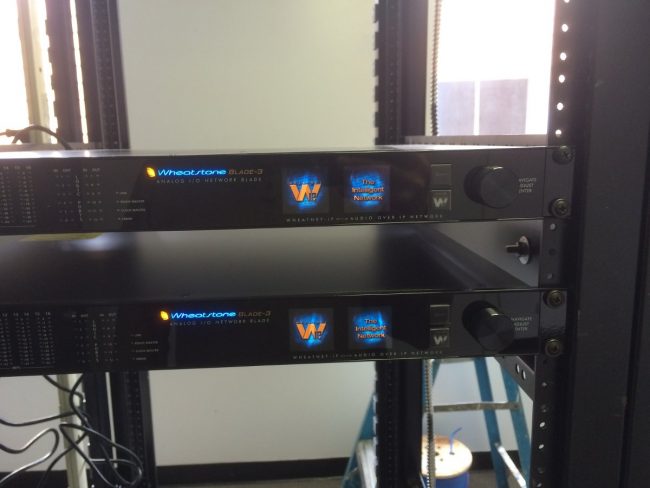
The switches are managed units. The switchports need to be set up via command line to pass VLAN traffic. There is an appendix in the IP88 manual that outlines how to do this with various managed switches. This is the most important step for drop-out free audio. The switchports that connect to the two radios are set up as trunk ports using either VTP or 802.1Q.
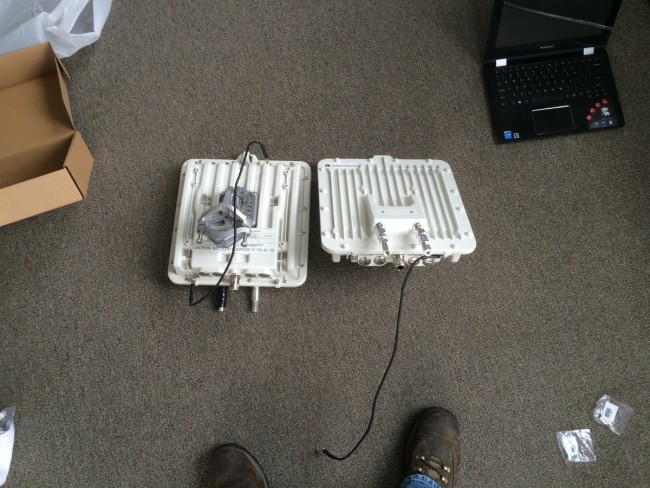
The PTP-250 radios were already on hand, new in the box. They are built really well and look like they should not break in a year or so. These particular units are connectorized, therefore an external antenna was needed. There are many such antennas, this system ended up with an RF Engineering & Energy 5150-5850 MHz dual-polarized parabolic dish with RADOMES. RADOMES are necessary to prevent ice or snow build up in the winter.
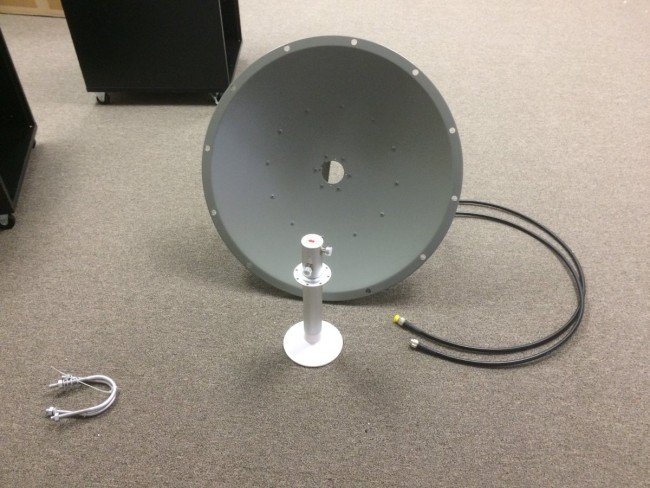
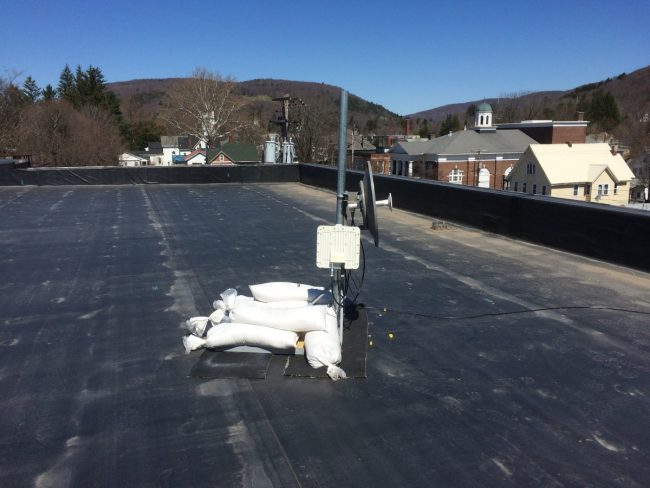
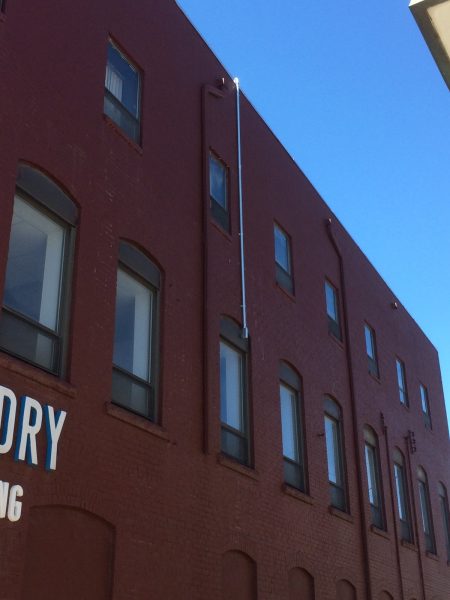
Since the path is only 3.37 miles (5.43 kilometers), I set them up with a 40 MHz wide channel. This is a rural, small-town setting. When I looked at the 5.8 GHz band on a spectrum analyzer, it looks fairly uncongested. These are MIMO single or dual payload selectable. I will try them as single payload units since the path is short and the band is uncongested. This should keep the throughput high.

The PTP-250s use POE injectors in mounted in the rack rooms. CAT5e shielded cable with the proper connectors properly applied is a must for lighting protection. The PTP-250 units came with Cambium PTP-LPU lightning protectors. I also installed Polyphaser AL-L8XM-MA type N surge suppressors on each RF port of each PTP-250.


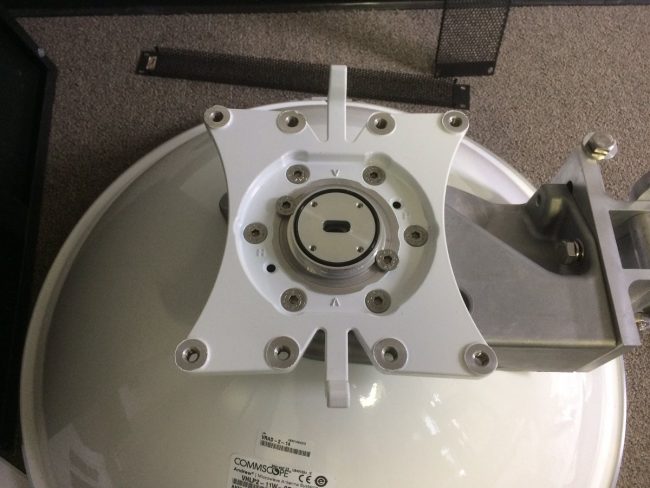
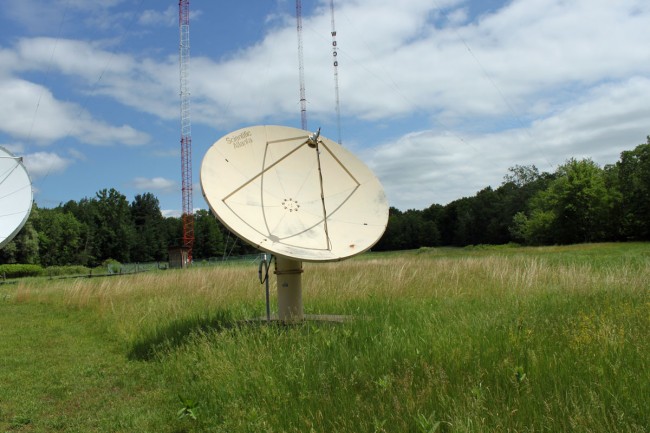
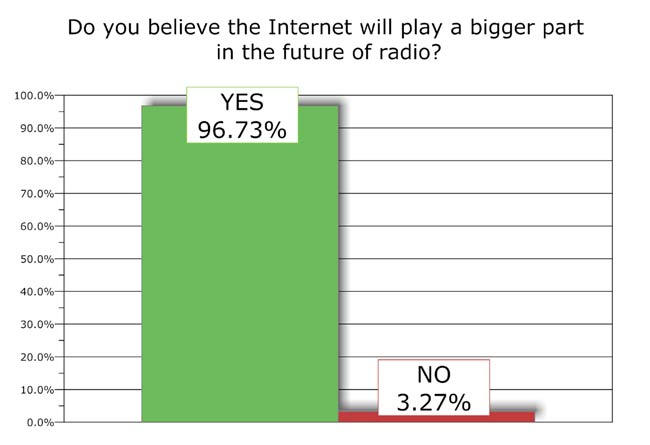
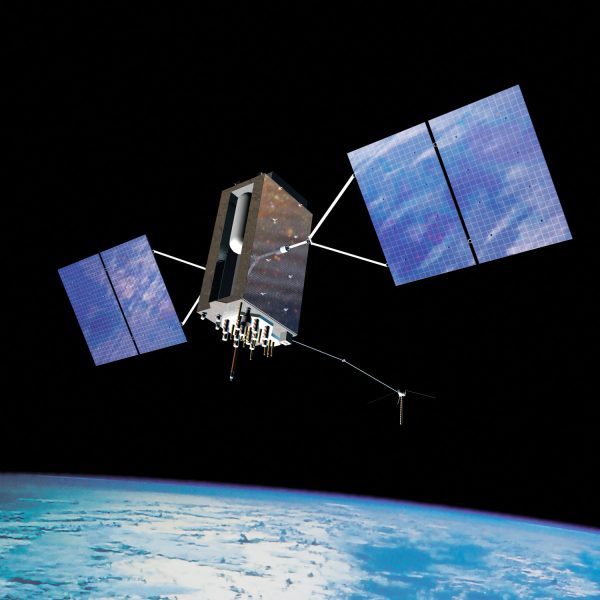
5 radio stations on one STL? So if that unit fails, all five radio stations go out at the same time? I like their idea, but I’m not a fan of IP based STLs. Use an FM sub carrier for getting transmitter readings and alarms, you don’t even have to leave it on, you can configure a request and send system using your existing STL.
That is like Christmas lights – when one goes out, they all go out! It will get you started, but IP based links need to be further tested. It better not use lossy compression, that stuff sucks!
Newer IP radios and IP audio equipment has come a long ways. I care for a couple stations that are using Ubiquity Airfiber 5x radios and an axia analog xnode at each end with great results. Don’t even think about trying it on “consumer grade” wireless gear like Ubiquiti Rocket M5 (tried it, ended terribly)..
The Cambium radios are good stuff, if not a little pricey, but good stuff. I’ve not had the chance to try the Wheatstone gear, only axia so far, I imagine they both work in a similar fashion.
In my case, I have two FMs at one site and an AM at another site. I have 3 wireless links:
Studio -> FM -> AM -> Studio Mikrotik router at each site running OSPF and QoS. Guarantee priority to audio streams. Works great, even with other traffic on the link, since I’m doing routed, I can’t pass VLANs between sites, but I can prioritize packets which accomplishes more or less the same result – dropout free audio – and redundancy. We can lose any link in the network and everything stays on the air.
All remote control and telemetry comes over these links as well. have IP and phone connectivity, phone is VoIP over the links as well though, POTS too expensive and unreliable these days. ATT is letting all their copper rot in place, I suspect others are doing the same.
Sure, the IP link on that unit has a high bandwidth, you probably could run TV across that if you wanted. I like the idea, but in looking at station operations, IP based links have a latency. Try to do a live broadcast with a delay! I don’t know what your format is, but if you wanted to do a remote broadcast at a retail location, you are gonna have an echo between you and the transmitter.
But there is also another issue – re-sampling. How many generations of DA AD do you have before you get the transmitter? If you are receiving a satellite feed, usually that is digital, and most are still Dolby AC3 two channel. So, starting from the satellite feed:
The studio at the uplink side of the satellite feed is usually analog to digital, using an audio processor.
If the studio is using a computer (call it a CD source for explanation’s sake) that source is 44.1 Digital to analog. That goes through a sound mixer, to the audio processor which is sometimes analog and often times digital. From the audio processor, there’s a 50/50 chance that the connection to the satellite audio encoder is digital. But in many places there is a studio to transmitter link that converts from analog to digital, then on the receive end, back to analog. From that, it goes back to digital, (usually) to lossy compression (AC3, etc), gets transmitted to the satellite…
Now, at your antenna location, the audio is received from the satellite, decoded from lossy compression and converted from digital to analog. The satellite receiver is connected to your Wheatstone unit, which is analog to digital – it has to be because you can’t word clock in two directions with multiple sources. Ok, maybe, but lets be real here. Now, you receive the audio from the satellite, via your Wheatstone STL at the studio, yes, digital to analog. I will presume your mixer is analog, but if it was digital, there is another stage.
Now from the sound mixer, you either go to an audio processor which can be analog or digital, and then go back to the Wheatstone STL, which is Analog to digital. At the transmitter site, you go from the Wheatstone STL from digital to analog.
So, by the time that audio gets to the airwaves, it sounds like total CRAPPPPPPPPP! (substitute for a word you cannot say on the radio that is the name of a brand of headphone amplifier)
And, Neil, your competitor, does an engineering study, finds a good 1KW-6KW channel space, obtains a construction permit, sets up a tower or even uses something simple like a tall power pole as a tower, and completes an FCC license for 1 station. To build the studio, he uses an inexpensive used broadcast mixer, heck, even a DJ mixer, a PC, his own proprietary FM audio processor which is analog, and a rebuilt 900 Mhz range pro STL to send a composite analog signal to the transmitter site. The transmitter side sends its meter readings and alarms via a subcarrier on the FM transmitter. This way, monitoring and diagnosis can be done anywhere in the range of the transmitter. Control and operation of the transmitter is done via touch tones or other data on a lower subcarrier transmitted from the studio. The subcarriers do not have to be on continuously, the studio could simply turn on the 67Khz and send a request for readings. If an alarm triggered, the receive side in the studio would initiate an alarm. The receive side is a radio, which means you have an air monitor.
And my radio station, with one transmitter with only ONE D to A conversion will sound at least 30 times clearer than your large investment. My satellite dish would be located on the studio’s roof, or in very close vicinity to the studio, so that in the event of snow, insects or wind, it is a short trip to re-point. And yes, I have installed hundreds of KU band dishes on the top of buildings just like your STL antenna, I used to work for a contractor to DMX music.
And when I want to sell advertising to support my station and its employees, I can use a cell phone or good old fashioned MARTI to do live broadcasts from in town, with NO echo or latency, short of the speed of light.
Get it? Did anyone think about how radio works before spending hundreds of thousands of dollars developing an IP based link system? Did you ever actually work in radio and use the equipment?
Live broadcasts are key factors in your existence!
Sound quality is not a secondary factor in broadcasting, it should be top priority as you are now competing with handheld digital devices. You need to sound better than the cell phone or the mp3 player!
IP works just fine provided you have a stable link, it isn’t 1995 anymore. The ‘all your eggs on one basket’ thing is certainly a consideration, but so is getting the job done economically and efficiently. Building the system with proven, reliable equipment as Steven noted (and as was done here) is key.
I can’t imagine finding 8 open STL frequencies in even mid-sized markets these days, much less copper telco pairs or ISDN lines. The transport is going to have to be combined in one fashion or another.
Same with SCA-based telemetry. Unless you have a fixed control point it’s simply making life more difficult and complex, not simpler.
I’m still skeevish on sandbags out in the sun though. I don’t trust the bagging material in the sun long-term.
I’ve had success converting Harris Intraplex to use Ethernet WAN instead of T-1. They have a new card called the CM-30 which replaces the old CM-5 processor / T-1 interface. We replaced 5 point-to-point T-1s with a metro Ethernet circuit which has presence at 5 sites. Metro Ethernet works like a big layer 2 switch with the telco company being in the middle. The failover capability with Ethernet WAN allows for creative solutions that make it more reliable than the T-1 ever was. In my case, three of our paths were between different studio locations that also shared an office metro Ethernet network. I built an OSPF network that used GRE tunnels through the office network and fast OSPF hellos with a one second dead timer. If a router misses OSPF hellos from it’s neighbor for a second or more it will instantly transition to use the path through the office network tunnel and send an alert to my syslog server which sends me an email. A 5 Gigahertz link or a cable modem could easily be used as an alternate failover path. The cost savings from giving up the T-1s is substantial.
Stephen: I’m using a set of Rockets for my IBOC data path and have had no trouble. It’s a short hop and all I’m using it for is HD and to connect the Burk gear to the aux site so it is loafing. Just curious about your experience(s) with the Ubiquity gear (you refer to it as “consumer gear”)
The rocket platform is getting old and is indeed based on a consumer level wifi chipset. With that said, it’s a good product. My experience has been in applications where you are sending many small packets, they tend to fall on their face pretty quickly if conditions aren’t perfect.
In my application, the rockets did not perform, too many audio glitches to be acceptable with the axia xnodes. With the bric link, it was flawless. We also had a problem with Ethernet ports getting zapped in thunderstorms, even after revisiting grounding and protection. This has not happened with the airfiber 5x units.
Admittedly, I’m not terribly familiar with iboc… Poor local broadcasters in ms don’t get to play with such… Are you running the audio as well as other data or just the data stream for text and anything else you may be sending ?
I am curious to do some testing with the rocket ac units. I have a couple links up we are using to take Internet access to areas outside our cable plant coverage with really good results and lower latency and jitter than the original rocket units.
I’ve also heard about the lightning issues with the Rockets. I have an extra set on hand for that very reason. I have only had these guys on the air for a few months and have never experienced a summer thunderstorm with these radios – I may learn to hate them before Labor Day arrives…
IBOC is UDP so if the data stream is interrupted you will get glitches in the audio. So far…knock on wood…pristine HD performance. That too may change as time marches on.
I guess if I was doing this as a design project, I would use a composite analog link on the FMs, and then use one of these for all the other stuff. I can’t imagine you have 5 new FM licenses in one market. This way, you have reliable feeds running the important stuff and you can at least get audio to the others in the event of a failure of the multi-system.
Yes, I would avoid telco stuff at all cost, you could buy redundant units for the price the phone company will charge you over a year or two.
I guess as a design plan, I would make sure that all of my sources like satellite, are on site of the station. The solution here is a redundancy of these units. and to have a few analog links. It will get you on the air, but beware of the problems that might occur in the future. My guess is that these studio to transmitter links have a 5 year lifespan, presuming lightning or heat doesn’t blow them.
Chuck, we’ll keep an eye on the sandbags. The building owner was very specific about no cinder blocks on the new rubber membrane roof.
Mike, good information on the interplexes. We use those for many different clients, having an IP option is a good fall back position when the phone company finally does away with DS-1.
Tom/Steve, I have uses some of the Ubiquity stuff in various places. We have one site using them for video camera backhaul. They are ok, but I’d rather use something else if funding permitted.
Neil, I suppose having unlimited budgets must be a thing? To install composite STLs for all these stations would cost a shit ton of money. Here is my breakdown on that proposal:
4 composite STL transmitter/receiver pairs: $12,000
1 Mono STL transmitter/receiver pair: $2,000
2 Scala PR-950U antennas: $2,000
1 Five port transmitter combiner: $3,500
1 five port receiver power divider: $750
430 feet, 7/8 foam coax: $1,075
Tower crew to hang antennas: $2,300
Licensing coordination and filing: $8,500
Total: $32,125.00
And that system has zero redundancy, zero.
Compare that to this:
3 Wheatstone IP88A blades: $9,000
2 Existing Cambium PTP-250 radios: $0
Tower crew to re-point antenna: $800
Total: $9,800
This system has a spare IP88A, preconfigured and a spare Cambium PTP-250 radio, preconfigured. Additionally, the IP88A serve as an audio router and satellite audio can be configured to be routed to various transmitter directly in the case of a link failure or power outage at the studio.
Neil, Here in Boston. (top 10 radio market), there is a large FM cluster doing the exact same thing as in this post.
A little bigger setup (bigger antenna, dual path, etc), but the principal is the same. I can name off a dozen other stations using this type of IP link across the northeast as well. And, it’s rock solid. I hear of more issues with the 900 Digital STLs than I do with the IP links. The trend is going in this direction, not back into the old analog days. The industry is moving away from 900 links for new setups. And with the newer codecs and quality of equipment, the audio quality is fantastic. Not even close to low bit rate digital (mp3) or Analog.